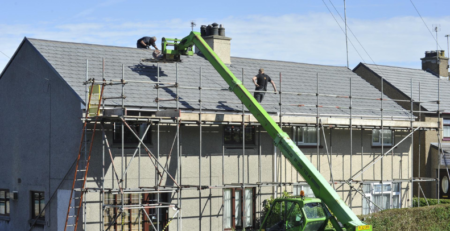Do I Need Planning Permission for a Driveway?
If you are thinking of building a new driveway or perhaps widening your existing one, you will need to have a good understanding whether you need planning permission for a driveway.
Driveways are increasingly being requested as part of the planning process. Many individuals, especially those who live in highly populated regions across towns and cities, find on-street parking to be a necessity and not a choice. However, this implies that you may not always be able to get a parking spot in front of your house, which is why having a driveway is a common goal for many homeowners.
It’s no surprise that driveway designs are becoming more popular as more and more people choose electric vehicles (EVs) that require a home charging station. Indeed, if the UK is to meet its net-zero carbon strategy, many more cars will need to be parked on driveways to gain access to charging.
According to the Government, “Electric vehicles (or EVs) offer one method of reducing emissions. In May 2019, the Committee for Climate Change (CCC) suggested that all new vehicles should be electrically propelled by 2035, if not sooner, to achieve the Net Zero target. The UK government is accelerating the transition to zero emission cars and vans”. As a homeowner, this includes securing the proper planning approval for driveways, so that they may be built with the least interruption.
Is planning permission for a driveway necessary?
If you want a driveway, you may or may not need to get planning approval, depending on your particular circumstances. For example, with new build projects, the driveway details should be listed in the “access” portion of the planning application. To figure out what is being asked for driveways, investors in buy-to-let properties or people who want to buy off-plan homes will need to look at the planning application.
In certain cases, if the driveway is for an existing property, planning approval is not required since it falls under the Permitted Development category. This means that you already have planning permission and can go ahead with your driveway improvement without having to get permission from the local government.

There are some exceptions to Permitted Development privileges, so proceed with caution. To avoid having to file a retrospective planning application, which has its own set of risks and expenses, it’s always better to double-check before starting any driveway project work.
What circumstances don’t apply to Development Rights?
Flats and maisonettes do not have permitted development rights, which means you don’t need to get permission for driveways. This makes sense when you think about the limited space available for them.
Permitted Development rights do not apply to homes that were previously things like launderettes, betting offices, food takeaways, other commercial and service offices, as well as storage or distribution centres, amusement arcades, casinos, and agricultural buildings. In other words, they do not apply to properties that were converted into dwellings via other Permitted Development rights.
Permitted Development rights are not applicable if they were expressly withdrawn as a condition of approval from an existing house’s planning permission.
In certain parts of the nation, all properties within a given area have had their Permitted Development rights rescinded. Driveways require planning approval if any of these exceptions apply to your home.
If you live in a listed building, you’ll need both planning and listed building approval before making any changes. This is because the area around a listed structure is also protected by the listing.
What about if you want to convert your garden into a driveway?
If the driveway is smaller than five square metres in size, you don’t need planning approval to replace or put a new hard surface there. There are certain modest front yards where simply two paved tracks for your vehicle’s wheels would be enough for a “wheel tracks driveway.”
Planning permission isn’t needed if you use porous surfaces like gravel, permeable concrete block pavement, or porous asphalt to make a driveway bigger than that. As long as the rain is directed to a nearby grass or flower border to drain, you don’t need permission.
In the conversion of part or all of a front yard into a driveway, you will very likely need the use of an existing pavement to access the driveway from the road, in which case you will almost certainly require a licence and/or planning approval for dropped kerbs.
What about if you want to widen your existing driveway?
If your driveway lies directly in front of your house, that is, between the road and the area of your property’s main elevation, you will still require planning approval to enlarge it. This restriction applies if you are proposing a typical, impermeable driveway that does not enable water to drain into a permeable area, such as a grass or flower border, and the driveway is greater than five square metres in size.
There will likely be no limits on the sort of driveway space you may cover with impermeable hard surfaces if it is on land other than your front garden, and you will not need to submit a planning application. As long as they are at or close to ground level, you should be able to proceed with this job without difficulty.
But keep in mind that the major elevation of your house may not be what you expected it to be, or what you wanted it to be. If your property is located near a bend or the orientation of your house with respect to the road is not conventional, you should get guidance from a planning specialist on this.
Applying for planning permission
For driveways that are directly connected to a current property, applicants must go through the householder application process in order to gain planning permission for them.
It will cost £206, which is payable to your local planning authority to submit the application, in addition to whatever your planning consultant charges you for their time and skills in preparing the application. When you’re planning your driveway renovation, you need to think about these extra costs.
You may be thinking of doing the application yourself, in which case, start by visiting the website of your local planning authority, which will offer guidance on how to do this.
The whole application process will take about 8 weeks or so, but in some areas, it will take much longer due to a backlog, especially since the pandemic has caused major disruptions. It is doubtful that a council representative will visit for inspection at present until things return to some kind of normality.
ARE YOU READY TO START INVESTING?
Subscribe to our mailing list now for exclusive deals, investment guides and the latest information from the property market.






